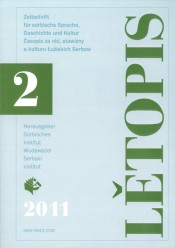Niedersorbische/Wendische Beschriftungen im öffentlichen Raum der Niederlausitz vom 19. bis zur Mitte des 20. Jahr¬hunderts. Eine Dokumentation
Lower Sorbian/Wendish public signs in Lower Lusatia from the 19th to the middle of the 20th Century. A documentation
Author(s): Alfred Roggan, Simon Alfred Roggan, Katja AtanasowSubject(s): History
Published by: Domowina-Verlag GmbH / Ludowe nakładnistwo Domowina
Keywords: Lower Sorbian; Sorbian; Prussian; Wendish; Cottbus; Inschriften; Beschriftungen; Sprachdenkmal; niedersorbisch; Niederlausitz; Lower Lusatia; Lower Sorbian; Sorbian; Wendish; sign
Summary/Abstract: It can be demonstrated that Lower Sorbian has been used in the public sphere for 165 years. However, up to 1945 (or 1937) the language did not go beyond the religious or ritual sphere. The use of Lower Sorbian on street signs and buildings was rare. There were two exceptions: the land survey of Drebkau in 1846 by the Prussian state and the signs on the branch of the Wendish Volksbank AG in Cottbus (1928–1933). As a result the work of committed priests in Cottbus and the surrounding area was of decisive importance. Lower Sor-bian inscriptions, mostly biblical sayings, can be found on galleries, bells and confirmation certificates. In addition, there are Lower Sorbian words on gravestones; however, only a few of these are preserved due to the length of time the graves have existed. The term “Wendish Regional Church” can contribute to an understanding of the historical and artistic particu-larities of Lower Lusatia and to a comparison with other regions of Germany.
- Issue Year: 2011
- Issue No: 2
- Page Range: 3-35
- Page Count: 33
- Language: German
- Content File-PDF

